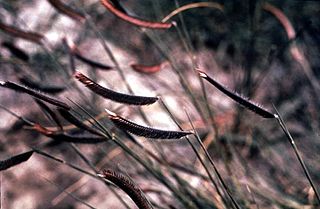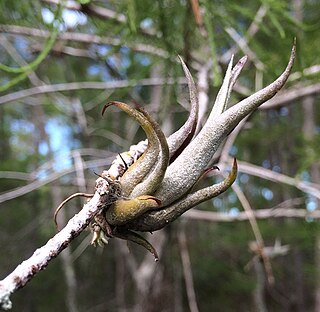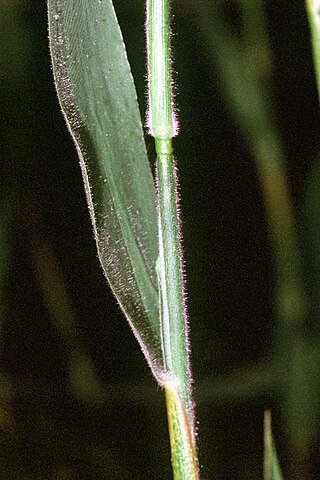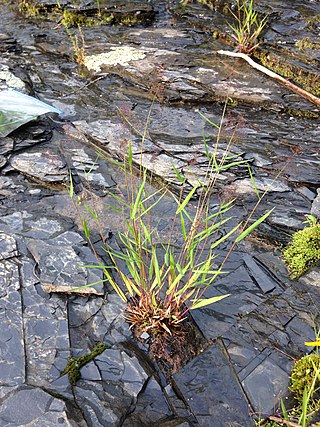
Flowering plants are plants that bear flowers and fruits, and form the clade Angiospermae, commonly called angiosperms. They include insect-pollinated herbs such as buttercups, pond plants such as water lilies, wind-pollinated grasses, and trees such as apple and oak. The term "angiosperm" is derived from the Greek words ἀγγεῖον /angeion and σπέρμα / sperma ('seed'), meaning that the seeds are enclosed within a fruit. They are by far the most diverse group of land plants with 64 orders, 416 families, approximately 13,000 known genera and 300,000 known species. Angiosperms were formerly called Magnoliophyta.

Vicia sativa, known as the common vetch, garden vetch, tare or simply vetch, is a nitrogen-fixing leguminous plant in the family Fabaceae. It is likely native to North Africa, Western Asia and Europe, but is now naturalized in temperate and subtropical regions worldwide. Although considered a weed when found growing in a cultivated grainfield, this hardy plant is often grown as a green manure, livestock fodder or rotation crop. More than 500,000 hectares per year of Vicia sativa is grown in Australia.

Pollination is the transfer of pollen from an anther of a plant to the stigma of a plant, later enabling fertilisation and the production of seeds, most often by an animal or by wind. Pollinating agents can be animals such as insects, birds, and bats; water; wind; and even plants themselves, when self-pollination occurs within a closed flower. Pollination often occurs within a species. When pollination occurs between species, it can produce hybrid offspring in nature and in plant breeding work.

The monarch butterfly or simply monarch is a milkweed butterfly in the family Nymphalidae. Other common names, depending on region, include milkweed, common tiger, wanderer, and black-veined brown. It is amongst the most familiar of North American butterflies and an iconic pollinator, although it is not an especially effective pollinator of milkweeds. Its wings feature an easily recognizable black, orange, and white pattern, with a wingspan of 8.9–10.2 cm (3.5–4.0 in). A Müllerian mimic, the viceroy butterfly, is similar in color and pattern, but is markedly smaller and has an extra black stripe across each hindwing.

Heliconia is a genus of flowering plants in the monotypic family Heliconiaceae. Most of the ca 194 known species are native to the tropical Americas, but a few are indigenous to certain islands of the western Pacific and Maluku in Indonesia. Many species of Heliconia are found in the tropical forests of these regions. Most species are listed as either vulnerable or data deficient by the IUCN Red List of threatened species. Several species are widely cultivated as ornamentals, and a few are naturalized in Florida, Gambia, and Thailand.

Dichanthelium is genus of flowering plants of the grass family, Poaceae. They are known commonly as rosette grasses and panicgrasses.

Campanula americana, the American bellflower, or tall bellflower, is a bellflower native to eastern North America. Tall bellflowers can be annual or biennial with a varying life-history with seeds germinating in the fall producing annual plants and spring-germinating seeds producing biennial plants. Long-tongued bees are the primary pollinators, including Megachile campanulae, but halictid bees, butterflies, and skippers may also act as pollinators. Tall Bellflowers do not generally self-pollinate. Some authorities, including the USDA PLANTS database, consider the name Campanulastrum americanum to be the accepted name for this species.

Erythranthe guttata, with the common names seep monkeyflower and common yellow monkeyflower, is a yellow bee-pollinated annual or perennial plant. It was formerly known as Mimulus guttatus.

Raphanus raphanistrum, also known as wild radish, white charlock or jointed charlock, is a flowering plant in the family Brassicaceae. One of its subspecies, Raphanus raphanistrum subsp. sativus, includes a diverse variety of cultivated radishes. The species is native to western Asia, Europe and parts of Northern Africa. It has been introduced into most parts of the world and is regarded as a habitat threatening invasive species in many areas, for example, Australia. It spreads rapidly and is often found growing on roadsides or in other places where the ground has been disturbed.

Agrostis stolonifera is a perennial grass species in the family Poaceae.

Brachypodium distachyon, commonly called purple false brome or stiff brome, is a grass species native to southern Europe, northern Africa and southwestern Asia east to India. It is related to the major cereal grain species wheat, barley, oats, maize, rice, rye, sorghum, and millet. It has many qualities that make it an excellent model organism for functional genomics research in temperate grasses, cereals, and dedicated biofuel crops such as switchgrass. These attributes include small genome diploid accessions, a series of polyploid accessions, a small physical stature, self-fertility, a short lifecycle, simple growth requirements, and an efficient transformation system. The genome of Brachypodium distachyon has been sequenced and published in Nature in 2010.

Bouteloua gracilis, the blue grama, is a long-lived, warm-season (C4) perennial grass, native to North America.

Solanum rostratum is a species of nightshade that is native to the United States and northern and central Mexico. Common names include buffalobur nightshade, buffalo-bur, spiny nightshade, Colorado bur, Kansas thistle, bad woman, Mexican thistle, and Texas thistle.

Tillandsia paucifolia, the potbelly airplant, is a species of bromeliad in the genus Tillandsia. This species is native to Central America, central and southern Mexico, Venezuela, Colombia, the West Indies, and Florida.

Psathyrostachys juncea is a species of grass known by the common name Russian wildrye. It was formerly classified as Elymus junceus. It is native to Russia and China, and has been introduced to other parts of the world, such as Canada and the United States. Psathyrostachys juncea is a great source of food for grazing animals, as it has high nutrition value in its dense basal leaves, even in the late summer and autumn seasons. This species can grow and prosper in many harsh environments, making it an ideal candidate for improvement as it can grow in areas were farming is difficult. This species is a drought-resistant forage plant and can survive during the cool seasons. It is also a cross-pollinator and is self-sterile. This means that P. juncea cannot self-fertilize; it must find another plant of the same species with which to exchange gametes. Self-sterilization increases the genetic diversity of a species.

Dichanthelium clandestinum is a species of grass known by the common name deertongue. It is native to eastern North America, including eastern Canada and the eastern United States.

Dichanthelium scoparium is a species of grass known by the common names velvet panicum, velvety panicgrass, and broom panicgrass. It is native to North America, where it occurs in the southeastern United States. It also occurs in the West Indies.

Dichanthelium lindheimeri, commonly called Lindheimer panicgrass, is a species of flowering plant in the grass family (Poaceae). It is native primarily to eastern areas the United States and Canada, with its range extending into the South Central region. There are also outlying western populations in California, New Mexico and Oregon.

















